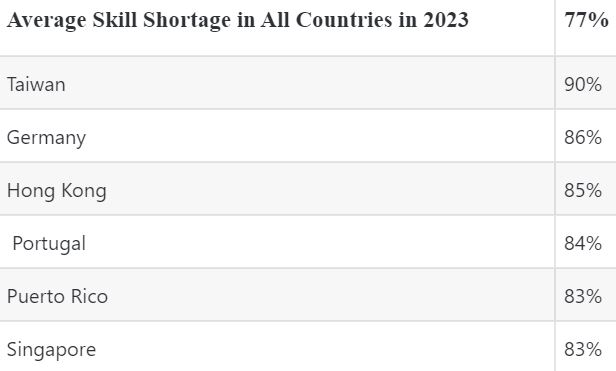It’s hard to fathom a world where countries teeming with infrastructure, finance, and machines face a crisis not because they lack these assets but because they are running short of a vital resource – labor. This predicament, akin to the chilling prophecy of “winter is coming” in the famed Game of Thrones series, is increasingly becoming a stark reality for several developed nations today.
Germany, home to the world’s fourth-largest economy, finds itself wrestling with this problem. It is expected that by 2035, Germany could face a staggering shortage of up to 7 million workers. Consequently, the nation is now reconsidering its immigration policies in a desperate bid to attract foreign workers to bridge this gap.
But Germany isn’t the only one facing this crisis. Japan, the world’s third-largest economy, and the UK, which was surpassed by India in 2022 as the world’s sixth-largest economy, are witnessing similar labor shortfalls.

Two primary reasons are driving this labor shortage in these countries. The first is a decreasing birth rate – a trend common in developed nations where educational advancements and a shift in societal norms lead to fewer childbirths. The second reason is an increase in life expectancy, courtesy of the country’s advanced medical sector. This combination of low birth rates and a surge in the elderly population is contributing to a widening gap in the workforce.
A prolonged labor shortage can have devastating impacts on these economies. A diminished workforce means these countries can produce less, leading to a slowdown in their GDP growth. It could also lead to a mismatch between available workers and the skills demanded by the market, thereby stunting innovation and productivity.

While the labor shortage crisis poses a significant challenge to the developed world, it also presents a unique opportunity for populous nations like India and China. India has the potential to become the ‘Labor Capital’ of the world, given its massive labor force and the high proficiency of English language amongst its populace. According to various surveys, Indians are known for their industriousness, making them ideal candidates to fill these labor gaps.
However, there are hurdles. India’s persisting unemployment problem prevents it from fully utilizing this demographic dividend. Therefore, if India wishes to leverage this situation to its advantage, it must take measures to mitigate its domestic unemployment crisis.
Moreover, the brain drain phenomenon – the emigration of highly skilled workers – might be perceived as a concern. However, it’s important to note that while there is no dearth of talent in India, the country has often struggled to offer the appropriate avenues and platforms for this talent to flourish. This is exemplified by the fact that Indian-born professionals like Sundar Pichai and Satya Nadella hold CEO positions in multinational companies.
The potential benefits of becoming a labor supplier to the world are immense. One of the significant advantages is the inflow of remittances – the money these workers send back to their families. In 2022, India topped the charts by receiving over $100 billion in remittances, thereby strengthening its forex reserves and providing a cushion against external economic shocks.
If utilized effectively, this situation can also enhance India’s growth and elevate its status as a global soft power. However, it will require concerted efforts from the Indian government, including provisions for language and skill training aligning with global needs.
To sum it up, the labor shortage crisis in developed economies is a pressing issue that calls for immediate solutions. While this predicament poses significant challenges, it also presents a silver lining for populous nations like India and China. The coming years will determine how these nations navigate this complex situation and potentially turn a global crisis into an opportunity for socio-economic growth.
















